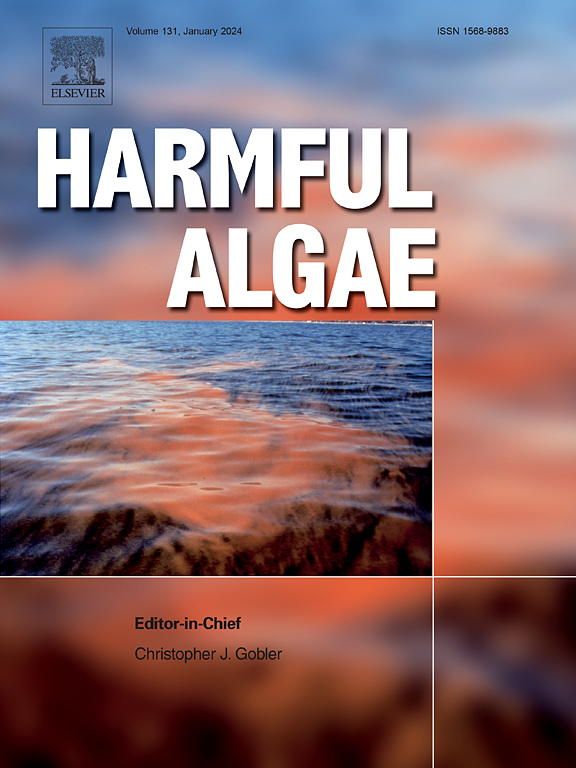The effect of temperature and salinity on Margalefidinium polykrikoides group III VA, USA strain growth
IF 4.5
1区 生物学
Q1 MARINE & FRESHWATER BIOLOGY
引用次数: 0
Abstract
Margalefidinium polykrikoides is a cosmopolitan dinoflagellate that blooms in coastal waters. Despite genomic evidence that it belongs to Group III and so closely related to isolates from Puerto Rico, Malaysia, North America, and Central America, M. polykrikoides blooms in the Chesapeake Bay at warmer temperatures and lower salinities than in coastal ecosystems occupied by its closest relatives. In this study, the effect of temperature and salinity on the growth rate and total cell yield of an M. polykrikoides VA culture isolate were examined and compared with environmental observations made during M. polykrikoides blooms in the Chesapeake Bay. M. polykrikoides group III VA strain grew at 18–32 ̊C and 15–30 salinity. M. polykrikoides group III VA strain grew better at warmer temperatures and lower salinities than other M. polykrikoides strains from related groups, but did not grow at 16 or 34 ̊C or at a salinity of 10. Low salinity and excessively warm temperatures interacted to inhibit M. polykrikoides group III VA strain growth at 32 ̊C and 15 salinity. Temperature and salinity likely interact in estuarine waters to inhibit or promote M. polykrikoides bloom initiation and development. The range of water temperatures observed during M. polykrikoides blooms in the Chesapeake Bay was narrower than what was observed for most of the other dinoflagellate species that bloom there, but the range of salinity was the broadest. M. polykrikoides bloomed at warmer temperatures and higher salinities than most of the other bloom-forming dinoflagellate species in the Bay.
温度和盐度对Margalefidinium polykrikoides group III VA, USA菌株生长的影响
Margalefidinium polykrikoides是一种世界性的鞭毛藻,在沿海水域繁殖。尽管基因组证据表明它属于第三类,并且与来自波多黎各、马来西亚、北美和中美洲的分离株密切相关,但与它的近亲所占据的沿海生态系统相比,多krikoides在切萨皮克湾的温度更高、盐度更低。本研究研究了温度和盐度对多核线虫VA培养分离物生长速率和总细胞产量的影响,并与切萨皮克湾多核线虫繁殖期间的环境观测结果进行了比较。多krikoides III组VA菌株在18 ~ 32℃、15 ~ 30盐度条件下生长。聚核样分枝杆菌III组VA菌株在较高的温度和较低的盐度下生长较好,但在16℃、34℃和盐度为10时均不能生长。在32℃和15℃的盐度条件下,低盐度和过暖温度相互作用抑制了多核样m.s polykrikoides III组VA菌株的生长。河口水温和盐度可能相互作用,抑制或促进聚krikoides水华的发生和发展。在切萨皮克湾,多krikoides藻华期间观察到的水温范围比在那里开花的大多数其他鞭毛藻物种要窄,但盐度范围是最广泛的。与海湾中大多数其他形成水华的鞭毛藻物种相比,多krikoides在更温暖的温度和更高的盐度下开花。
本文章由计算机程序翻译,如有差异,请以英文原文为准。
求助全文
约1分钟内获得全文
求助全文
来源期刊

Harmful Algae
生物-海洋与淡水生物学
CiteScore
12.50
自引率
15.20%
发文量
122
审稿时长
7.5 months
期刊介绍:
This journal provides a forum to promote knowledge of harmful microalgae and macroalgae, including cyanobacteria, as well as monitoring, management and control of these organisms.
 求助内容:
求助内容: 应助结果提醒方式:
应助结果提醒方式:


